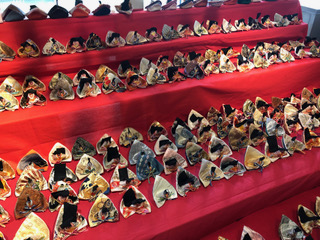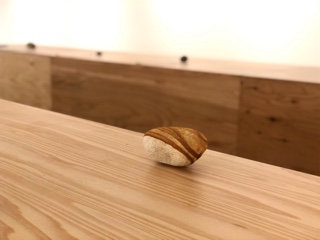I remember
- At March 11, 2021
- By admin
- In Annes Letters
 0
0
Dear Family and Friends,
In Sendai there is a museum that honors The Great East Japan Earthquake and Tsunami. Currently there is an arrangement of small figures made of kimono material. They represent the souls of those lost on March 11, 2011.

There is also a piece called I remember: memories of the disaster and a parenting for 10 years. It consists of a simple platform with smooth wooden eggs placed at regular intervals. The surrounding walls have a parade of dates stretching thousands of years into the past and forward into the future. It subtly reminds us that we are truly part of an eternal process, continuously expressed through the tragic and beautiful vicissitudes of life.

People here believe the souls of the departed return to earth at special times. The deceased long to communicate with the living, and to both give and receive blessings. And indeed, the feeling here has been quietly different the past few weeks. Because of that, I felt an urge to visit several areas close to sea. I have gone to connect to others, living and dead, and to my own inner need for remembering.
A friend told me she had been feeling the same way. So, recently, she went to Fukushima, to the very edge permitted for visitors, close to the devastated nuclear energy station. She was especially struck by the bareness of it all, with homes left empty for ten years, yet one lone temple gate still standing.


My day trips were near Sendai. Arahama, or Rough Coast, is renowned for the middle school where students and faculty fled to the roof and watched the tsunami roar through the rooms where they had just been studying. Miraculously, the building was strong enough to withstand the onslaught, and was left intact to become a museum.
When I went this time, however, the school was closed. But nearby was a small open-air museum consisting of the actual ruins of devastated houses. There was also a tsunami wall, more a barrier to give people a fraction more time to escape, rather than a guarantee of no harm. Now it is used for recreation: walking, jogging, bike riding. The beach, now clean of debris, is enjoyed by fishermen and families, school kids and young sweethearts.


Today I headed to the newly planted forest near Sendai Airport. I had been there a few days after the tsunami. At that time, I was shocked by the amount of damage and debris everywhere. But now the forests are growing nicely. There is also a wide park that stretches along the coast. There used to be farms, but they are no longer allowed so close to the sea.

The tsunami hit at exactly 14:46. I wanted to be there at that time. I went early and was almost the only one there. Compared to Arahama and despite the newly made park, this place at first seemed severe and unwelcoming. But gradually people began to arrive. Soon there was a steady stream of them, all coming to sound the bell of prayer and to remember.

Then without a word, worshippers stopped queuing and quietly formed a semi-circle around the bell. There was complete silence as people reverently waited. On the dot of 14:46 a short siren sounded, and in unison everyone bowed their heads. For a moment it was as if time stood still.
After a few minutes the spell was broken. Some people turned to leave, others went forward to pray. Some remained reflective, a few resumed their interrupted conversations.

Landscape that Weaves Memories by Nakagawa Kazutoshi
Love,
Anne
PS. NHK made a very touching documentary on how people in one small town coped emotionally after March 11, 2011. It was filmed five years ago. But what they did then is probably still happening now. Processing grief takes a long time. This film also gives very interesting insights into Japanese rural culture.
https://www3.nhk.or.jp/nhkworld/en/ondemand/video/4001232/
In Sendai there is a museum that honors The Great East Japan Earthquake and Tsunami. Currently there is an arrangement of small figures made of kimono material. They represent the souls of those lost on March 11, 2011.

There is also a piece called I remember: memories of the disaster and a parenting for 10 years. It consists of a simple platform with smooth wooden eggs placed at regular intervals. The surrounding walls have a parade of dates stretching thousands of years into the past and forward into the future. It subtly reminds us that we are truly part of an eternal process, continuously expressed through the tragic and beautiful vicissitudes of life.

People here believe the souls of the departed return to earth at special times. The deceased long to communicate with the living, and to both give and receive blessings. And indeed, the feeling here has been quietly different the past few weeks. Because of that, I felt an urge to visit several areas close to sea. I have gone to connect to others, living and dead, and to my own inner need for remembering.
A friend told me she had been feeling the same way. So, recently, she went to Fukushima, to the very edge permitted for visitors, close to the devastated nuclear energy station. She was especially struck by the bareness of it all, with homes left empty for ten years, yet one lone temple gate still standing.


My day trips were near Sendai. Arahama, or Rough Coast, is renowned for the middle school where students and faculty fled to the roof and watched the tsunami roar through the rooms where they had just been studying. Miraculously, the building was strong enough to withstand the onslaught, and was left intact to become a museum.
When I went this time, however, the school was closed. But nearby was a small open-air museum consisting of the actual ruins of devastated houses. There was also a tsunami wall, more a barrier to give people a fraction more time to escape, rather than a guarantee of no harm. Now it is used for recreation: walking, jogging, bike riding. The beach, now clean of debris, is enjoyed by fishermen and families, school kids and young sweethearts.

And all of it is watched over by Kannon. The God/dess of Compassion is there to protect and provide reassurance. In all, Arahama has become a happy place without the energy of anxiety and sorrow that lingered for several years after the tsunami.

Today I headed to the newly planted forest near Sendai Airport. I had been there a few days after the tsunami. At that time, I was shocked by the amount of damage and debris everywhere. But now the forests are growing nicely. There is also a wide park that stretches along the coast. There used to be farms, but they are no longer allowed so close to the sea.

The tsunami hit at exactly 14:46. I wanted to be there at that time. I went early and was almost the only one there. Compared to Arahama and despite the newly made park, this place at first seemed severe and unwelcoming. But gradually people began to arrive. Soon there was a steady stream of them, all coming to sound the bell of prayer and to remember.

Then without a word, worshippers stopped queuing and quietly formed a semi-circle around the bell. There was complete silence as people reverently waited. On the dot of 14:46 a short siren sounded, and in unison everyone bowed their heads. For a moment it was as if time stood still.
After a few minutes the spell was broken. Some people turned to leave, others went forward to pray. Some remained reflective, a few resumed their interrupted conversations.
And so, life went on.
Disasters are ingrained in the Japanese DNA. They come, cause havoc, and leave. But people always say, “We are here. So, let’s help wherever is needed, and enjoy whenever we can.” And in that spirit, they continuously “Build Back Better” for a safer, hope-filled tomorrow.
Disasters are ingrained in the Japanese DNA. They come, cause havoc, and leave. But people always say, “We are here. So, let’s help wherever is needed, and enjoy whenever we can.” And in that spirit, they continuously “Build Back Better” for a safer, hope-filled tomorrow.

Landscape that Weaves Memories by Nakagawa Kazutoshi
Love,
Anne
PS. NHK made a very touching documentary on how people in one small town coped emotionally after March 11, 2011. It was filmed five years ago. But what they did then is probably still happening now. Processing grief takes a long time. This film also gives very interesting insights into Japanese rural culture.
https://www3.nhk.or.jp/nhkworld/en/ondemand/video/4001232/



